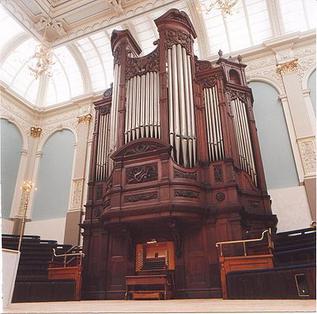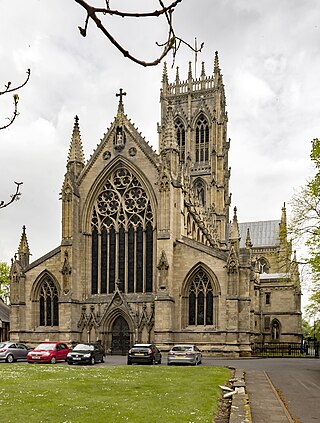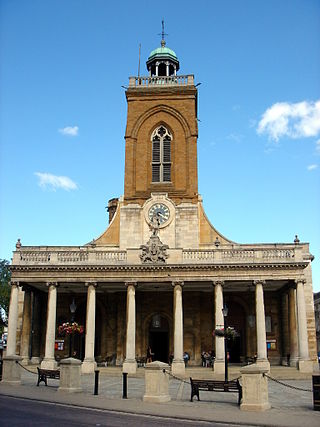Related Research Articles

Aristide Cavaillé-Coll was a French organ builder. He has the reputation of being the most distinguished organ builder of the 19th century. He pioneered innovations in the art and science of organ building that permeated the profession and influenced the course of organ building, composing and improvising through the early 20th century.

Henry Willis & Sons is a British firm of pipe organ builders founded in 1845. Although most of their installations have been in the UK, examples can be found in other countries.
N.P Mander Limited later Mander Organs Limited was an English pipe organ maker and refurbisher based in London. Although well known for many years in the organ building industry, they achieved wider notability in 2004 with the refurbishment of the Royal Albert Hall's Father Willis Grand Organ. That company filed for insolvency in 2020 with their trading name and intellectual rights being bought out by the Canterbury firm F. H Browne and Sons.

Doncaster Minster, formally the Minster and Parish Church of St George, is the Anglican minster church of Doncaster, South Yorkshire, England. It is a grade I listed building and was designed by architect designer George Gilbert Scott. The church was built in 1854–1858 to replace an earlier building destroyed by fire. It is an active place of worship and has a Schulze organ, a ring of eight bells, and a celebrated clock by Dent. The church is one of two parish churches to have minster status in South Yorkshire. The other is the minster church of Rotherham.

All Saints' Church, Northampton is a Church of England parish church in the centre of Northampton. The current church was largely built after a fire and was consecrated in 1680. It is a Grade I listed building.

The Grand Organ situated in the Royal Albert Hall in London is the second largest pipe organ in the United Kingdom, after the Liverpool Cathedral Grand Organ.

Henry Willis, also known as "Father" Willis, was an English organ player and builder, who is regarded as the foremost organ builder of the Victorian era. His company Henry Willis & Sons remains in business.

The Brighton Dome is an arts venue in Brighton, England, that contains the Concert Hall, the Corn Exchange and the Studio Theatre. All three venues are linked to the rest of the Royal Pavilion Estate by a tunnel to the Royal Pavilion in Pavilion Gardens and through shared corridors to Brighton Museum. The Brighton Dome is a Grade I listed building.

St Peter's Church is a church in Brighton in the English city of Brighton and Hove. It is near the centre of the city, on an island between two major roads, the A23 London Road and A270 Lewes Road. Built from 1824–28 to a design by Sir Charles Barry, it is arguably the finest example of the pre-Victorian Gothic Revival style. It is a Grade II* listed building. It was the parish church of Brighton from 1873 to 2007 and is sometimes unofficially referred to as "Brighton's cathedral".

St Peter's Church is a Church of England parish church located in the centre of Bournemouth, Dorset, England. It is a Grade I listed building classed as a 'major parish church', and was completed in 1879 to a design by George Edmund Street as the founding mother church of Bournemouth.

All Saints Hove is an Anglican church in Hove, part of the English city of Brighton and Hove. It has served as the parish church for the whole of Hove since 1892, and stands in a prominent location at a major crossroads in central Hove.

J. W. Walker & Sons Ltd is a British firm of organ builders established in 1828 by Joseph William Walker in London. Walker organs were popular additions to churches during the Gothic Revival era of church building and restoration in Victorian Britain, and instruments built by Walker are found in many churches around the UK and in other countries. The firm continues to build organs today.

Charles Lloyd was a pipe organ builder based in Nottingham who flourished between 1859 and 1908.
The Hampstead Conservatoire was a private college for music and the arts at 64, Eton Avenue, Swiss Cottage, London.

All Saints' Church is in Queens Road, Hertford, Hertfordshire, England. It is an active Anglican parish church in the deanery of Hertford and Ware, the archdeaconry of Hertford, and the diocese of St Albans. It is the civic church of the town and of the county. The church is recorded in the National Heritage List for England as a designated Grade II* listed building. It is the largest church in Hertfordshire, other than St Albans Cathedral, and can seat up to 1,000 people.

All Saints Church, Cheltenham, is a Grade I listed parish church in the Church of England in Cheltenham.

George Maydwell Holdich was a British organist and organ builder based in London.

St Augustine's Church, Wrangthorn, usually referred to as simply Wrangthorn, is the church of the parish of Woodhouse and Wrangthorn, Leeds, West Yorkshire, England. It is near Hyde Park Corner at the top of Woodhouse Moor. It shares a benefice and clergy with St George's Church in the city centre, although the parishes remain separate. It was paid for by the Leeds Church Extension Society in 1866 and completed in 1871. The church, which is a Grade II listed building is on a ridge of land between Meanwood Beck and the Aire Valley, on the north-west side of the city. Its architect, James Barlow Fraser (1835–1922), took advantage of this prominent location by including a three-stage pointed steeple; its blackened stone is a local landmark. The church is built in local gritstone ashlar in the Gothic Revival style and is adjoined by the smaller church hall of 1934.
A. Hunter & Son was an English pipe organ maker and refurbisher, established in London in 1856. Hunter was best known for the instruments at St Cuthbert's Philbeach Gardens and St James's, Spanish Place. The firm was acquired by Henry Willis & Sons in 1937.
References
- ↑ "The National Pipe Organ Register - the Chapel Royal, Brighton".
- ↑ "The National Pipe Organ Register - the Hampstead Conservatoire of Music".
- ↑ "The National Pipe Organ Register - St Peter's, Brighton: The Willis Organ".
- ↑ "The National Pipe Organ Register - St Peter's, Brighton: The Old Organ".
- ↑ "The National Pipe Organ Register - St Paul's, St Albans".
- ↑ "The National Pipe Organ Register - Saint Mary's, Kemp Town: the Lincoln organ".
- ↑ "The National Pipe Organ Register - Saint Mary's, Kemp Town: the Bevington organ".
- ↑ "The National Pipe Organ Register - Saint Mary's, Kemp Town: the Bevington organ, as rebuilt in 1965".
- ↑ "The National Pipe Organ Register - The Brighton Dome Willis".
- ↑ "The National Pipe Organ Register - The Brighton Dome HNB".
- ↑ "The National Pipe Organ Register - All Saints, Hove: 1894 specification".
- ↑ "The National Pipe Organ Register - All Saints, Hove: 1905 specification".
- ↑ "My Brighton and Hove: Hove Town Hall - A history of two buildings".
- ↑ "The National Pipe Organ Register - Hove Town Hall".
- ↑ "The National Pipe Organ Register - Haberdashers' Aske's Boys' School".
- ↑ "My Brighton and Hove: Hove Town Hall - A history of two buildings".